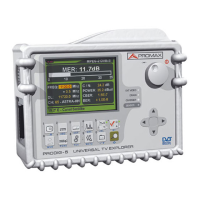USER’S MANUAL. PRODIG-5
11/2006 Page 61
English
If there is an excess of sound carrier, tearing or 'moiré' may appear on the screen
due to the frequency beats between the sound, chrominance and the picture
frequencies.
If there is a chrominance carrier defect, then the television colour amplifier must
function at maximum gain, which could result in noise appearing all over the television
screen with points of colour that disappear when the saturation control is reduced; in an
extreme case, loss of colour may occur.
5.15.1 Markers
(Only in Spectrum Analyser mode). The marker in red colour indicates the central
frequency or tuning frequency, which can be moved by means of turning the rotary
selector [1] as well in channel as in frequency tuning mode
[24].
When monitoring a digital signal spectrum also appears two additional markers in
white colour, which indicate the bandwidth of the digital channel (See previous Figure).
5.16 TV Operating Mode
When pressing the [2] key from any mode of operation the PRODIG-5
(EXPLORER) accedes to the TV mode, and tries to demodules on the monitor the
currently tuned video signal.
In the monitor will appear the TV picture with a window on the lower part to show,
for five seconds, in the case that the signal is analogue, the channel number, the
frequency, the active canalization, the colour system and the TV standard.
DTV
(FREE)
VPID:
PID:
101
103
MP@ML
720x576i
4:3 50 Hz
Component
CHANNEL:
CCIR
DVB-T
66
834.00 MHz
100
12289
VISTA TV
NETW.: VistaNetw
VIDEO:
AUDIO:
3999
192
kbit/s
kbit/s
MPEG-2
MPEG-1 L-2
SID:
NID:
- -
OSD: ON
Figure 36.- Digital channel monitoring.

